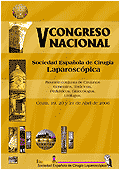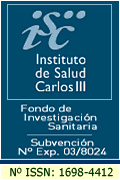
 Version en español
Version en español
DISCUSSION
The aneurysms of visceral arteries are more commonly found in the splenic artery (60%). They are rarely discovered (1,6-10,6%), but with a mortality risk of 36% in cases of rupture (2% of the cases). The therapeutic options are: classical open-surgery, laparoscopy or endovascular treatment. Clinical and anatomical criteria have been set to indicate the treatment in programmed or urgent operations. In the I° group: young fertile women, aneurysms with diameter ≥2 cm or in rapid growth; in the II° group: symptomatic cases with abdominal pain, hemodynamics instability or shock. Management of SAAs still remains controversial. Laparoscopic SAA ligation repair appears to be optimal and useful for aneurysms protruding from the pancreas and it is gaining interest because clinical recovery is rapid with a poor morbidity and economic and cosmetic advantages. Transcatheter embolization too offers a temporary control in urgency to stop haemorrhage and go back at later date to make much better elective operation. Endovascular interventions as percutaneous embolization has recently gained popularity: it offers a safe alternative or adjunctive therapy to traditional surgery (3). Chiesa et al. believe that an aggressive surgical approach is justified, even in the case of asymptomatic visceral artery aneurysms, because of the low morbidity and mortality rates; endovascular treatment should be reserved for selected cases (1). Lagana et al. consider that using different techniques, endovascular treatment is feasible in nearly all SAAs; it ensures good immediate and long term results and no doubt presents some advantages in comparison to surgical treatment, as it is less invasive and allows the preservation of splenic function (4). In the present review of the literature, to date, we have not identified any cases of SAAs treated with the Combined Laparoscopic Robotic Technique (CLRT).





